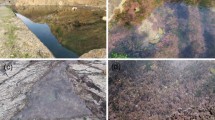Abstract
The seasonal behavior of both vegetative cells and cysts of dinophytes Scrippsiella spp., mostly S. trochoidea, which is the dominant group among dinoflagellate populations in Onagawa Bay on the northeastern coast of Honshu, Japan, was investigated between 1990 and 1992. The germination of the cysts after 8 d incubation under favorable laboratory conditions was examined using the extinction dilution method. Incessant germination occurred throughout the year, but the germination ratio (no. of germinable cysts/total cysts) varied seasonally with a marked fluctuation during summer when vegetative cells in the water column were abundant. Although such fluctuation largely reflects the variable flux of newly deposited immature cysts produced by the vegetative cells, the regulation of germination caused by a lowered saturation of dissolved oxygen (DO) under thermally stratified conditions was also suggested. During winter, while the cysts germinated in the laboratory, vegetative cells were not found in the water column. These facts suggest that germination in situ is regulated by low temperature in winter and possibly by lowered DO and by cyst age as well in summer. Such regulation prevents simultaneous germination of all the cysts, which is disadvantageous for the population because it would be more difficult to survive adverse conditions such as successive nutrient depletion and higher grazing risk.
Similar content being viewed by others
References
An KH, Lassus P, Maggi P, Bardouil M, Truquet P (1992) Dinoflagellate cyst changes and winter environmental conditions in Vilaine Bay, Southern Brittany (France). Bot Mar 35:61–67
Anderson DM (1984) Shellfish toxicity and dormant cysts in toxic dinoflagellate blooms. In: Ragelis E. (ed.) Seafood toxins. American Chemical Society, Washington DC, pp 125–138
Anderson DM, Keafer BA (1987) An endogenous annual clock in the toxic marine dinoflagellate Gonyaulax tamarensis. Nature, Lond 325:616–617
Anderson DM, Taylor CD, Armbrust EV (1987) The effects of darkness and anaerobiosis on dinoflagellate cyst germination. Limnol Oceanogr 32:340–351
Anderson DM, Wall D (1978) Potential importance of benthic cysts of Gonyaulax tamarensis and G. excavata in initiating toxic dinoflagellate blooms. J Phycol 14:224–234
Binder BJ, Anderson DM (1986) Green light-mediated photomor-phogenesis in a dinoflagellate resting cyst. Nature, Lond 322: 659–661
Binder BJ, Anderson DM (1987) Physiological and environmental control of germination in Scrippsiella trochoidea (Dinophyceae) resting cysts. J Phycol 23:99–107
Binder BJ, Anderson DM (1990) Biochemical composition and metabolic activity of Scrippsiella trochoidea (Dinophyceae) resting cysts. J Phycol 26:289–298
Dale B (1983) Dinoflagellate resting cysts: “benthic plankton”. In: Fryxell GA (ed) Survival strategies of the algae. Cambridge Univ Press, Cambridge, p 69–136
Endo T, Nagata H (1984) Resting and germination of cysts of Peridinium sp. (Dinophyceae). Bull Plankton Soc Japan 31:23–33 (in Japanese with English abstract)
Imai I (1990) Physiology, morphology, and ecology of cysts of Chattonella (Raphidophyceae), causative flagellates of noxious red tides in the Inland Sea of Japan. Bull Nansei natn Fish Res Inst 23:63–166 (in Japanese with English abstract)
Imai I, Itoh K, Anraku M (1984) Extinction dilution method for enumeration of dormant cells of red tide organisms in marine sediments. Bull Plankton Soc Japan 31:123–124
Imai I, Itoh K, Anraku M (1989) Dormancy and maturation in the cysts of Chattonella spp. (Raphidophyceae), red tide flagellates in the Inland Sea of Japan. In: Okaichi T, Anderson DM, Nemoto T (eds) Red tides: biology, environmental science, and toxicology Elsevier, New York, pp 289–292
Ishikawa A (1992) Population dynamics of the dominant dinoflagellates Scrippsiella spp. in Onagawa Bay, Northeastern Honshu, Japan. M Agr Sci Thesis Tohoku Univ, Sendai, Japan (In Japanese with English abstract)
Ishikawa A, Taniguchi A (1993) Some cysts of the genus Scrippsiella (Dinophyceae) newly found in Japanese waters. Bull Plankton Soc Japan 40:1–7
Jørgensen BB (1982) Mineralization of organic matter in the sea bed —the role of sulfate reduction. Nature, Lond 296:643–645
Kobayashi S, Yuki K (1991) Distribution of dinoflagellate cysts in surface sediments. Japanese coastal waters II. Matoya Bay Bull Plankton Soc Japan 38:9–23 (in Japanese with English abstract)
Lirdwitayaprasit T, Okaichi T, Montani S, Ochi T, Anderson DM (1990) Changes in cell chemical composition during the life cycle of Scrippsiella trochoidea (Dinophyceae). J Phycol 26: 299–306
Matsuoka K, Fukuyo Y, Anderson DM (1989) Methods for modern dinoflagellate cyst studies. In: Okaichi T, Anderson DM, Nemoto T (eds) Red tides: biology, environmental science, and toxicology. Elsevier, New York, pp 461–479
Prakash A (1967) Growth and toxicity of a marine dinoflagellate, Gonyaulax tamarensis. J Fish Res Bd Can 24:1589–1606
Steidinger KA (1975) Basic factors influencing red tides. In: LoCicero VR (ed) Proc 1st int conf toxic dinoflagellate blooms. Mass Sci Tech Found, Wakefield, Massachusetts, pp 153–162
Strickland JDH, Parsons TR (1972) A practical handbook of seawater analysis. Fish Res Bd Can Bull 167:1–310
Throndsen J (1978) The dilution-culture method. In: Sournia A (ed) Phytoplankton manual. Unesco, Paris, pp 218–224
Wall D (1971) Biological problems concerning fossilizable dinoflagellates. Geosci. Man 3:1–15
Wall D (1975) Taxonomy and cysts of red-tide dinoflagellates. In: LoCicero VR (ed) Proc 1st int conf toxic dinoflagellate blooms. Mass Sci Tech Found, Wakefield, Massachusetts, pp 249–255
Wall D, Guillard RRL, Dale B, Swift E, Watabe N (1970) Calcitic resting cysts in Peridinium trochoideum (Stein) Lemmermann, an autotrophic marine dinoflagellate. Phycologia 9:151–156
Watanabe MM, Watanabe M, Fukuyo Y (1982) Encystment and excystment of red tide flagellates I. Induction of encystment of Scrippsiella trochoidea. Res Rep natl Inst envirl Stud 30:27–42 (in Japanese with English abstract)
Author information
Authors and Affiliations
Additional information
Communicated by T. Ikeda, Nagasaki
Rights and permissions
About this article
Cite this article
Ishikawa, A., Taniguchi, A. The role of cysts on population dynamics of Scrippsiella spp. (Dinophyceae) in Onagawa Bay, northeast Japan. Marine Biology 119, 39–44 (1994). https://doi.org/10.1007/BF00350104
Received:
Accepted:
Issue Date:
DOI: https://doi.org/10.1007/BF00350104




